Why some MOSFET half-bridge power sections have Schottky diodes between the source and the gate of MOSFTETs? For example D1 and D5 in the schematics here:
4 Answers
The diodes are actually not across the gate and source, but they are in series with the gate:

simulate this circuit – Schematic created using CircuitLab
The idea is to speed up the turn off of the MOSFET: When the drive signal is high the gate-charge capacitance charges up through R11 and turns the MOSFET on, when the drive signal is low the gate-source capacitance discharges through D1 (relatively faster, although D1 has internal dynamic resistance). R14 is there to prevent accidental/noise turn on of the MOSFET (because input impedance is too high and therefore noise-sensitive) by ensuring Vgs is zero via a relatively smaller impedance, when the input is floating.
The reason of making turn on a bit slower is that high dv/dt (fast rise) across drain-source may cause ringing or some other problems.
- 26,954
- 3
- 25
- 67
-
5Electrically your schematic fragment and the OPs are identical (except for the diode symbol) but yours is drawn much clearer which alone answers the question. Well done and +1. – Ken Mercer Jul 11 '23 at 03:44
When a MOSFET is being switched off, by the driver output going low, gate capacitance is being discharged, and current flows to the left, out of the gate and back into the driver. In that direction, current experiences lower impedance due to the presence of diodes D1 and D5, resulting in the gate discharging faster than it charges, and thus the transistor tends to switch off slightly faster than it switches on.
This has the benefit of helping one transistor switch fully off slightly earlier than the other can switch fully on, a kind of "dead-time" which mitigates shoot-through current due to both transistors being on simultaneously.
D5 has a second benefit. When the upper MOSEFT Q1 switches on, and the lower MOSFET Q4 switches off, Q4's drain rapidly rises in potential, a change which is coupled back to the gate via "miller capacitance", a parasitic capacitance between gate and drain.
This results in so-called "miller current" flowing back out of Q4's gate towards the driver, via gate resistance R11. Consequently, there is a voltage dropped across R11 which raises gate potential, causing Q4 to switch back on again.
D5 decreases the effective resistance of this back-current path, limiting the voltage across across R11 to a maximum of 0.3V (or whatever the diode drops with that current flowing through it), and prevents Q4 from being switched on again.
- 27,759
- 2
- 16
- 87
The Schottky diodes provide a low impedance path for the discharge of MOSFET gates, thus reducing the turn-OFF time of the devices.
The circuit work as follows:
- At turn-ON the input voltage goes high while the gate to source voltage is still 0. The diode is reverse biased thus the total gate \$C_\text{G}\$ (nonlinear voltage-dependent) capacitance charges through the \$33\Omega\$ resistor.
- At turn-OFF the input voltage goes low while while the gate to source voltage is still at its higher turn-ON value. Therefore the diode is forward biased and the total gate \$C_\text{G}\$ (nonlinear voltage-dependent) capacitance discharges through a current which is nearly proportional to the \$\frac{\operatorname{d}}{\operatorname{d}t}V_\text{i}\$ value, irrespective of the value of the gate resistor. This enables the designer to obtain very short switching times, provided the driver can safely withstand large sink currents.
- 3,161
- 4
- 14
- 29
This arrangement offers a cheap way to introduce some dead-time between the transitions and limit the shoot-through currents. When the upper-side transistor turns off, it does it quickly considering the diode bypassing the series resistance. However, in the low-side, the drive is already up but delayed by the time constant made of the series resistance and the MOSFET \$C_{iss}\$, effectively delaying the turn-on of the transistor. The same occurs when the low-side transistor quickly turns off, then the upper-side turn-on is delayed following the same scenario.
A quick simulation with SIMetrix shows how high this shoot-through current can be without this \$RCD\$ network, actually with the resistance reduced to 1 ohm:
You see 50-A spikes during the transitions. To reduce them, increase both series resistances to 50 ohms or so and see how the driver voltages no longer overlap with each other:
The spikes are reduced to 5 A or so, nicely helping for power dissipation and noise.
- 20,420
- 1
- 16
- 50


